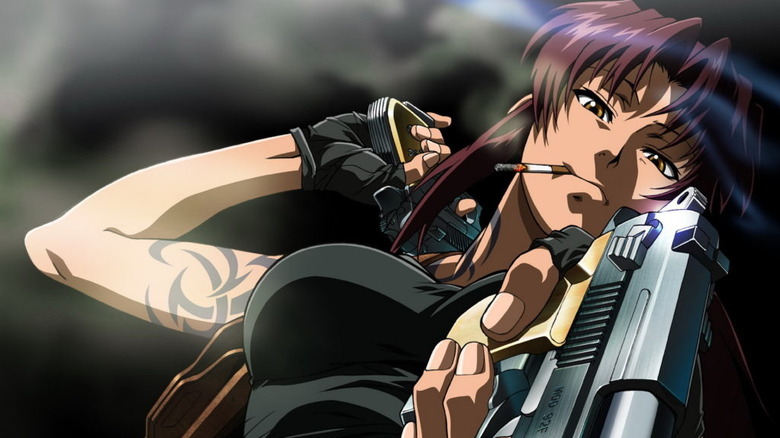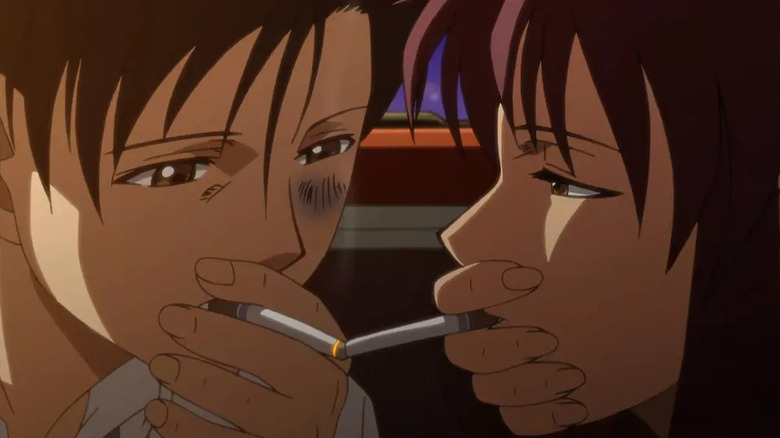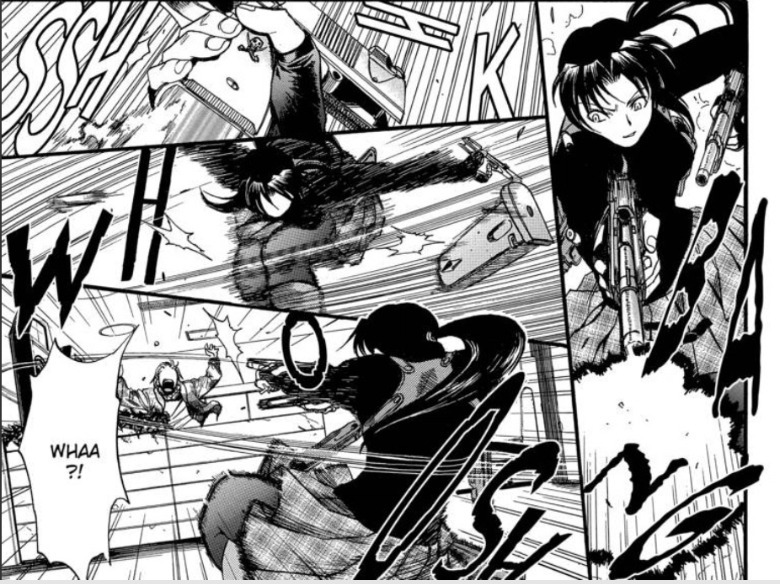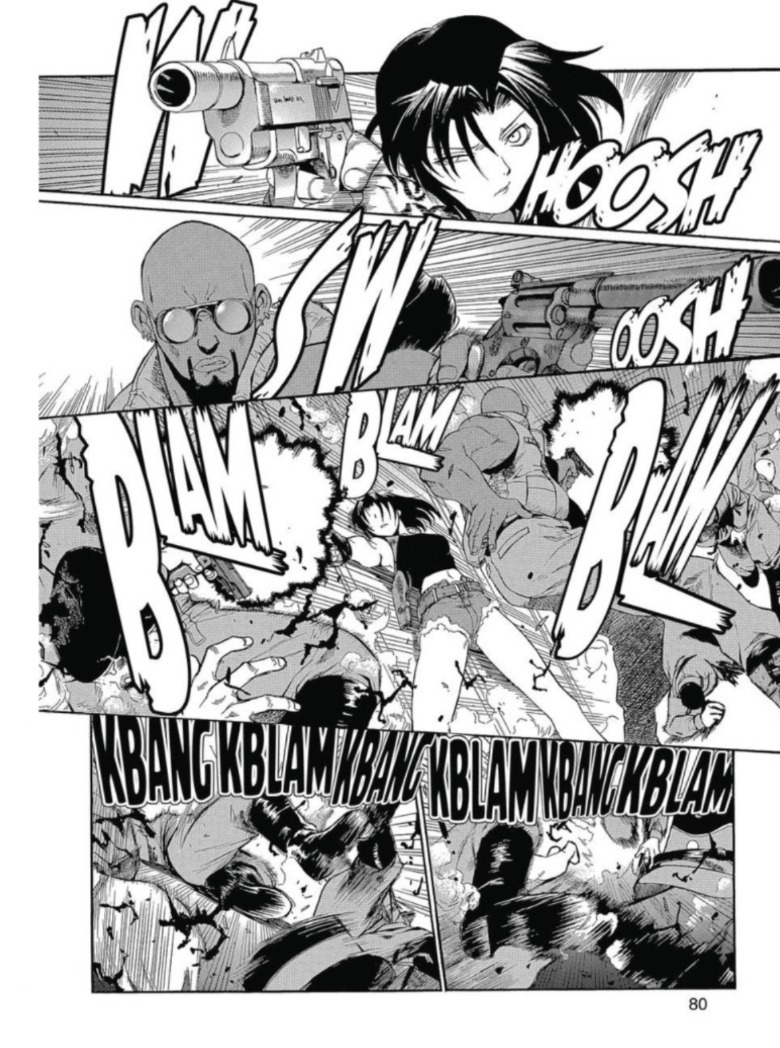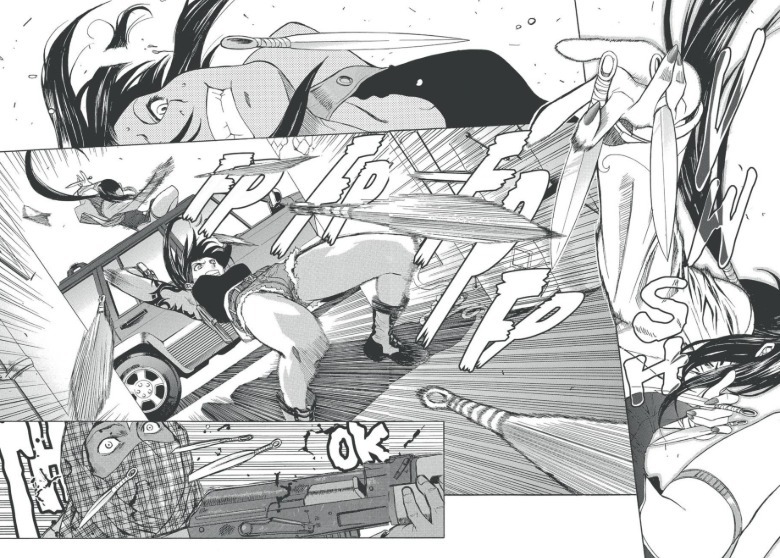This Crime Action Anime Is Perfect For Fans Of Quentin Tarantino And John Wick
We may receive a commission on purchases made from links.
Anime is filled with action series. That action is mostly "Dragon Ball"-flavored, though: superhuman martial arts, characters blasting energy or magical powers at each other, etc. However, if there's one anime that captures the kinetic, hot-lead-pumping feeling of a grown-up action film, it's "Black Lagoon." (No relation to the Creature from.)
In "Black Lagoon," the characters fight with guns, not any sort of Super Saiyan powers. The unrelenting pace and intensity of the series' shoot-outs is right out of John Woo's Hong Kong action films. (Or, for newer action fans, the "John Wick" films; "Wick" director Chad Stahelski is an anime fan.)
"Black Lagoon" lead Rokuro "Rock" Okajima is an overworked and middling office drone living in Japan in the 1990s. He's then sent on a business trip in the South China Sea, only to be taken hostage by a group of pirates from the Lagoon Trading Company: Dutch, their coolheaded leader, a supposed Vietnam War veteran who never went home; Benny, the group's tech support; and Rebecca "Revy" Lee, a nihilistic mercenary who's never seen without her two handguns.
Rock subsequently discovers the papers he's carrying are actually evidence of his bosses' shady dealings, and they intended for him to die and become the fall guy. Between that, some Stockholm syndrome, and proving himself a capable and quick-thinking pirate, Rock is inspired to join the Lagoon company instead. "Black Lagoon" follows the four leads taking mercenary jobs from their home base in Roanapur, a fictional port city in Thailand.
If you thought Mos Eisley on Tatooine in "Star Wars" was a "wretched hive of scum and villainy," you've never been to Roanapur. (It's also so similar conceptually to Madripoor, a South China sea island in Marvel Comics, that you half expect Wolverine/"Patch" to show up.) Numerous crime syndicates call Roanapur home: Chinese Triads, Colombian cartels, "Hotel Moscow," a Russian mob led by former Soviet soldier Sofiya Pavlovna "Balalaika" Irinovskaya, and the Church of Violence, a CIA-backed drug and gun trafficking ring who dress as nuns. "Black Lagoon" is all about our humble trading company navigating these syndicates and any newcomers to Roanapur who threaten to muck up business.
"Black Lagoon" began in 2002 as a manga authored by Rei Hiroe. Shortly after in 2006, it was made into an anime by the prolific studio Madhouse. Directed by Sunao Katabuchi, "Black Lagoon" ran for three seasons and 29 episodes of bloody fun.
Black Lagoon is an anime perfect for non-anime fans
In a 2017 interview with Otaku USA Magazine, Hiroe confirmed some of his influences for "Black Lagoon" — and they're ones you can spot even without his confirmation. That includes John Woo, yes, but also some other cinephile favorite directors like Quentin Tarantino and Sam Peckinpah. Dutch does appear to have been drawn to look like Samuel L. Jackson (Mr. Tarantino's most reused actor since "Pulp Fiction"), while the Lagoon Company's mix of amorality and camaraderie is quite like Peckinpah's "The Wild Bunch," too.
These influences speak to the fact that while "Black Lagoon" is an anime, it has none of the childish flourishes many Americans associate with the medium. There's no chibi animation bits, and the show's humor comes from sarcasm and one-liners (again, just like in an action movie).
There are also many American pop culture references, especially in the original manga, which helps the characters feel like they exist in the real world. Likewise, Hiroe's character designs are quite grounded; characters in "Black Lagoon" look and dress like normal people (well, normal criminals). The most out-there design choice is how Revy's brunette hair is shaded purple, but that's an age-old coloring technique.
Another inevitable comparison that "Black Lagoon" merits is to the 1998 space Western anime "Cowboy Bebop," another series that's often sold as an "anime for Americans who don't like anime." Like "Cowboy Bebop," it helps that "Black Lagoon" has an exemplary English dub.
"Black Lagoon" isn't science-fiction, and the crew travels in a boat, not a spaceship. Still, both series are about a four man band of mercenaries/bounty hunters scraping by. Dutch is as stern as Jet Black and Benny is a hacker much like Radical Edward. Rock and Revy similarly resemble Spike Spiegel and Faye Valentine, respectively, but Revy is the one with Spike's fatalism. Spike mused that "whatever happens, happens" all the way up to the tragic ending of "Cowboy Bebop." Revy isn't just devil-may-care, though; she's also bloodthirsty and a nihilist.
Given how dark and edgy "Black Lagoon" is, you're probably wondering: Is there any heart in this story and its characters? Well, if there is one, it's between Rock and Revy. Rock's arc is about corruption; he starts off as naive, often trying to help people in need whom the crew comes across. The longer he spends in Roanapur, the more he adapts to it. Revy disdains Rock at the beginning, but she sees him slipping into the darkness where she's always lived. Revy — a former street urchin wanted in New York for killing her abusive father and still living with the trauma of being raped by an NYPD officer (a man who was "supposed" to help her) — does not enjoy seeing innocence slowly die in front of her.
After the Black Lagoon anime ends, the manga continues
Since 2010, Hiroe (who suffers from depression) has taken numerous long hiatuses on "Black Lagoon" to focus on his mental health. He hasn't abandoned the manga, however; the most recent "Black Lagoon" chapter was published in December 2024. Still, that means that 23 years running, the series is still waiting for an ending. (Not that Hiroe's priority should be anything but his own health, to be clear.)
The "Black Lagoon" anime ends with the arc "El Baile de la Muerte," which was adapted as a five-episode season ("Roberta's Blood Trail") in 2010-2011. At the time, that was the last piece of the story to adapt. The manga has kept going since then, though, with two completed arcs since and a third one in progress. Hiroe has said a new "Black Lagoon" anime could also happen, but there's been no sign of one entering production. That's to say, if you need more once you finish the anime, the manga is there.
"Black Lagoon" is well-worth reading, even if most of it is stories you've already seen from the anime. Seeing them retold will be just as thrilling because Rei Hiroe is a genius cartoonist. The action scenes in the "Black Lagoon" manga are just as good as in the anime, maybe even better.
You'd think it wouldn't be so. How can a series of still images capture the thrill of an in-motion gun fight? The sound design in manga is also nonexistent. You can't hear the hammer slamming on the back of the gun with each shot, much less bullets punching through flesh, the shot echoing out as the gun fires, and so on. Hiroe is well aware of the differences between mediums, though, and works to tailor his scenes on that. As he once explained to Otaku USA:
"Film is an 'active' medium. With manga, it's as if you only have still frames, so you need to find the best moments in time to convey meaning and movement. But one of the advantages of manga is that you're not anchored to reality. For instance, you can make guns bigger than their physical counterparts and make explosions far larger and more gaudy. Those are tools I use to convey the same meaning."
You can also see that sense of exaggeration in the posing and framing of "Black Lagoon" action scenes. In a movie gunfight, a reload will probably be a quick beat. In a comic, you can draw a close-up panel of the mag slamming back into the gun and the reader can focus on that moment as long as they want.
Since you can't show characters literally moving in a manga, Hiroe makes their still poses as dramatic and powerful as possible — take when Revy ducks under some throwing knives (or when she and Dutch stand side by side blowing away some Neo-Nazis). If you like those, then "Black Lagoon" has plenty more like them in store.
"Black Lagoon" the anime is streaming on Crunchyroll, while the manga is available to read on Viz Media. Volumes 1-13 can also be purchased through retailers.

